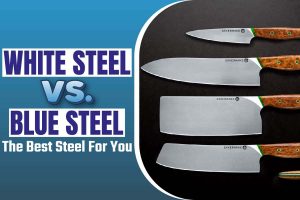Humans have always been out to create amazing things, structures, equipment, and tools. To build substantial structures, we need high-quality and robust raw materials. For this reason, humans have been mining various metals for centuries to make steel.
Over the years, steel has been refined, and it has become more robust and one of the most used metal alloys.
There are various types of steel in the market, and each has its advantages, disadvantages, and best uses. Let us break all these down and understand everything.
White Steel Vs. Blue Steel
White steel is a clean and pure type of steel. It is only made up of carbon and iron with no other alloy elements. While smelting white steel, there is special attention paid to reducing the amount of phosphorus and sulfur.
The purification results in producing a blade that is rock hard, but it still offers a decent amount of flexibility. The flexibility adds to the blade’s quality and makes it even more durable since it can withstand more pressure.
On the other hand, blue steel is more engineered and made for wear resistance or edge retention. White steel is used as a base for blue steel, but there is Tungsten, Manganese, phosphorous, Vanadium, and Chromium in blue steel.
This is steel with different kinds of carbides that are disbursed to be more resistant to wear and tear. This difference means you can use it for heavy-duty cuts for a long time before you need to replace it.
A Deeper Comparison Of The Blades
Whether you are a forger or knife user, you need to understand these two blades to know which one will serve you best. The best way to select is to have all the information about each blade and sort through it to determine the best one for you.
When it comes to forging, blue steel is the easiest to work with. This is because it is already well-engineered steel with a decent hardened structure to work with. All the bladesmith needs to do is handle it correctly.
Make sure you don’t overheat it; you don’t forge it in overly cold temperatures or work it in a way to produce a flaw. Keep any impurities away and stay in a suitable temperature range, and you shouldn’t have any problem with it.
White steel, on the other hand, is more problematic to forge. You have to build the blade from scratch with white steel since it’s not already structured like blue steel. It requires dedication, expertise, and passion for getting the best knife possible.
White steel has more potential than blue steel. It is easy to get to its best form for blue steel, making it seem like an easy choice. However, with patience and dedication, white steel can produce products of better quality than blue steel.
White steel produces more refined edges than blue steel if it is appropriately crafted. So if you want a blade for delicate tasks like wood carving or preparing food, then white steel will be the best choice for you.
Blue steel will be the best for uses that don’t need quality cuts. It can have fine edges, but its primary purpose is to cut through rigid material and keep its edge. It will generally be easier to maintain and sharpen.
How To Sharpen Dull Knives
Whether you use a white steel knife or a blue steel knife, it will get dull. The time it takes for a knife to get here will depend on the use and quality. So how do you get a dull knife back to its initial sharp state?
Steel is softer than you’d imagine, and it bends a little at the edge every time you use it to cut an object. This makes the blade crooked, and it doesn’t work as well as you want it to, which will become dangerous and disturbing for you.
You can use honing steel to refine the knife’s edge. This tool does not sharpen your knife; it will only straighten it out and make it easier to sharpen. This will also prevent the edge from breaking up when you sharpen the knife.
When working with the honing steel, you should keep roughly a 20% angle to maintain the edge. Pass the blade moving from the knife’s heel to the tip with consistent pressure on both sides. Go back and forth to ensure you line both ends.
If you don’t have knife handling skills, you can use a knife sharpener, so you don’t worry about the angles. The sharpener has a coarse and fine side, so you will have to start from the course side before going to the fine side.
A knife sharpener will maintain its initial angle and not eat into the blade’s age. This will ensure your knife remains high quality and it serves you for a long time.
How To Select Steel For Construction Or Knives
Regardless of the size of the project you are dealing with, you need to select the correct steel. Even if the project is small, you need to be keen since the steel is used in most integral parts of the building or the durability of your knives.
If you select the wrong steel, the building would either look ridiculous or structurally unsound. Both situations you don’t want to get yourself into as a construction manager. So let us break this down and see how you can make this choice;
1. Consider the diameter and grade of steel for construction
The diameter is the thickness of the steel, and it will have a lot to do with determining how strong the steel will be in the field. The small diameter steel would be best for light projects that won’t handle a lot of weight.
If you get steel that is not thick enough, it will be unable to support the weight of your project. This imbalance will cause the building to collapse after some time or in the event of seismic activity. A professional should know the best gauge for a project you plan to work on.
2. Think about the weight of the steel
The gross weight is the total mass of the building material and the occupants and everything added to the building. The weight of steel matters even in the forging of knives.
The weight of steel varies, and the user of the blade should consider it. A heavier blade might be capable of more tasks, but it could not be the best for delicate ones. Knowing what you are most comfortable with is the key to this discussion.
The weight of the steel will be a significant factor in you much the building will weigh and how well the ground can support it. If the construction is too heavy, it could fall because the ground or foundation cannot hold it up.
3. Check the steel for rust and loose coating
The structure you build will only be as good as the raw material you put into it. Before purchasing, check the rods and make sure that they have no rust on them and the coating is intact.
Steel that has rusted is often hard to work with, and it will be frustrating for your employees or to the one forging a blade. It will force you to clean it before using it, and it might not bind well with cement and concrete.
In knives, rust could compromise the microstructure of the blade, making it less durable. This means that clean steel is vital for construction and forging blades, so you should be keen on it.
4. Check for cracks
Look and ensure there are no cracks on the surface of the steel. Steel is one of the essential parts in maintaining the structure of the building, so you can’t compromise the steel structure.
Steel should be able to bend 1800 and back without breaking. If it has a crack, it will break instead of bending, which will be disastrous for your project. It could be a warning about the quality of the metal, and knives forged from it could break under pressure.
Conclusion
Both blue Steel and white steel are good options when you are looking for a blade. Each blade has its advantages and disadvantages during forging and use, so you have to be keen about your final choice.
Blue steel is structurally richer, and it has more alloy components to give it better edge retention. This feature makes it a good choice for crude and heavy-duty cutting tasks. White steel, on the other hand, is made simple to be flexible and efficient in cutting.
When choosing steel, you need to be careful to make the right choice. Whether you want steel for knives or construction, you must look for the best quality to get the best product.





















